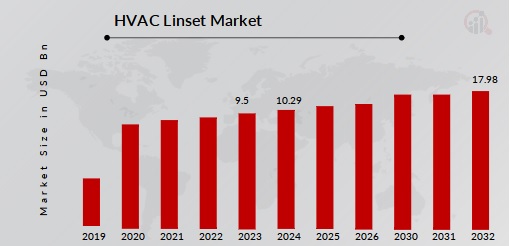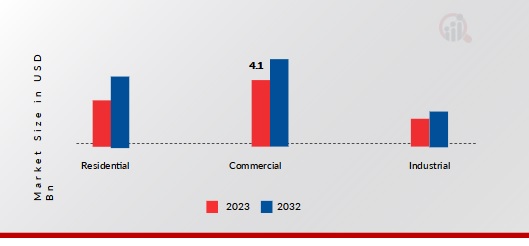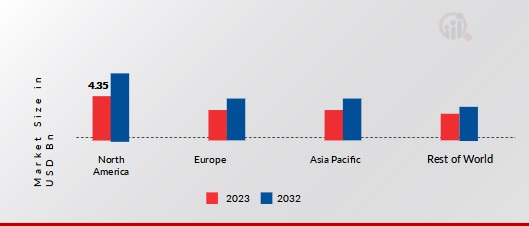HVAC Linset Market Size was valued at USD 10.29 Billion in 2024. The HVAC Linset industry is projected to grow from USD 11.14 Billion in 2025 to USD 22.84 Billion by 2034, exhibiting a compound annual growth rate (CAGR) of 8.30% during the forecast period (2025 - 2034). The increased need for HVAC linset systems will grow as urbanization, residential construction, and income growth all increase, which are the key market drivers boosting the expansion of the market.
Source: Primary Research, Secondary Research, MRFR Database and Analyst Review
HVAC Linset Market Trends
-
Growing urbanization and an increase in residential construction are driving the market growth
Market CAGR for HVAC Linset is being driven by the rising number of urbanization. HVAC linsets are crucial refrigerant conduits used in air conditioning, heating, and ventilation systems. They guarantee smooth transportation even in cold temperatures because they are low-carbon or copper-based. Urbanization, booming building, and rising air conditioner demand are the main drivers of rapid expansion. Growing industrial buildings and urbanization are the main factors propelling the growth of the HVAC Linsets Market. In affluent nations, urbanization has reached over 75%, whereas in underdeveloped nations, it is still in its infancy.
Additionally, urbanization is one of the main factors driving the need for HVAC systems. The United Nations projects that by 2050, there will be 6.7 billion people living in urban areas due to the growing rate of urbanization worldwide. Urbanization and rising housing demand lead to increased activity in the building industry. To maintain pleasant living conditions, this increases the requirement for strong HVAC (heating, ventilation, and air conditioning) systems. HVAC Linsets are essential parts of these systems that facilitate effective refrigerant flow. The need for Linsets is fueled by the simultaneous advancement of urbanization and residential construction, which highlights the growing need for efficient HVAC solutions.
The rising incomes of corporate workers offer a growth path for HVAC equipment, including air conditioners. It is anticipated that the combination of favorable climate conditions and rising wealth will encourage the use of air conditioners. For example, real personal discretionary income per head in China is expected to expand at an average annual rate of 7.2% between 2018 and 2030, based on EIU predictions. This suggests that there will likely be a demand for luxury goods like split air conditioners. Furthermore, the APAC region's middle-class population is expected to increase to 3.5 billion people by 2030, which would present growth prospects for HVAC systems in the future. The rise in income also encourages the construction of contemporary retail establishments, which in turn lowers demand. For instance, the International Energy Agency (IEA) projects that increased urbanization, rising income, and population growth will cause the energy demand for space cooling, or air conditioning, to quadruple by 2050. This rise in demand highlights the significance of HVAC systems and, consequently, line sets. HVAC systems are becoming more crucial to providing comfortable and climate-controlled environments when new buildings and infrastructure projects are constructed. HVAC line sets are essential parts that keep the proper flow of refrigerant between indoor and outdoor units, enabling these systems to function effectively. This results in driving the HVAC Linset market revenue.
HVAC Linset Market Segment Insights
HVAC Linset Material Insights
The HVAC Linset market segmentation, based on Material, includes Copper, Low carbon, and others. In 2023, the Low-carbon segment dominated the market. This is because of its remarkable aptitude for refrigerant transportation at temperatures as low as 500 F, and its carefully calibrated carbon content (0.04%–0.30%) reduces the possibility of leaks and guarantees resistance under extreme strain. Strong construction activity is another factor driving this rise.
HVAC Linset Implementation Insights
The HVAC Linset market segmentation, based on Implementation, includes New Construction, Retrofit. In 2023, the Retrofit category generated the most income. Retrofitting is the process of modernizing or altering a building's current HVAC system. Retrofitting enables the incorporation of new parts into systems that already exist. It supports environmentally friendly efforts and provides reasonably priced improvements. The need for retrofitting is driven by the desire to improve indoor air quality and energy efficiency.
HVAC Linset End-use Industry Insights
The HVAC Linset market segmentation, based on End-use Industry, includes Residential, Commercial, and Industrial. In 2023, the Commercial category generated the most income. The commercial sector's rise in the HVAC Linset market is driven by the rising need for cooling solutions in many sectors, including data centers, offices, hotels, supermarkets, and banks. High quantities are driven by this sector's large building area, ample open space, and numerous connections, which use low-carbon steel-based Linsets.
Figure 1: HVAC Linset Market, by End-use Industry, 2023&2032 (USD Billion) Source: Primary Research, Secondary Research, MRFR Database and Analyst Review
Source: Primary Research, Secondary Research, MRFR Database and Analyst Review
HVAC Linset Regional Insights
By region, the study provides the market insights into North America, Europe, Asia-Pacific, and the Rest of the World. The North American HVAC Linset market area will dominate this market, because of an increase in the expansion in the residential and commercial. In addition, the growing number of established health clubs and fitness facilities will boost market growth in this region.
Further, the major countries studied in the market report are Brazil, South Korea, China, Japan, India, Australia, Germany, France, the UK, Italy, and Spain.
Figure 2: HVAC LINSET MARKET SHARE BY REGION 2023 (USD Billion) Source: Primary Research, Secondary Research, MRFR Database and Analyst Review
Source: Primary Research, Secondary Research, MRFR Database and Analyst Review
Europe's HVAC Linset market has the second-largest portion of the market due to the popularity extending to linsets and other parts that improve system efficiency. Further, the German HVAC Linset market had the biggest market share, and the UK HVAC Linset market was the European market with the quickest rate of growth.
The Asia-Pacific HVAC Linset Market is anticipated to expand between 2024 and 2032 at the quickest CAGR. This is due to strong infrastructure improvements, urbanization, and affordable manufacturing in the area. Moreover, China’s HVAC Linset market had the biggest market share, and the Indian head Linset market was the Asia-Pacific region's fastest-growing market.
HVAC Linset Key Market Players& Competitive Insights
Leading market players are putting a lot of money into research and development to expand their product lines, which will drive the market for HVAC Linset to expand even further. Additionally, market players are engaging in a range of calculated initiatives to increase their worldwide presence, with important market developments involving the introduction of new products, contracts, M&A transactions, increased investment, and cooperation with other enterprises. To grow and endure in an increasingly cutthroat and dynamic market, the HVAC Linset industry must provide reasonably priced goods.
Manufacturing locally is one of the primary business techniques used by manufacturers to cut operational costs in the HVAC Linset industry to help customers and expand the market segment. In recent years, the HVAC Linset industry has provided some of the biggest benefits to medicine. Major players in the HVAC Linset market, including Daikin (Japan), Halcor (Greece), Hydro (Norway), KME SE (Germany), and Mueller Streamline Co. (US), JMF Company, Linesets Inc., are engaging in research and development activities in an effort to boost market demand.
Akira Yamada established Daikin Industries Ltd. in 1924 under the name Osaka Metalworking Industries LP, Osaka Kinzoku Kōgyōsho. Daiflon, also known as polychlorotrifluoroethylene, was created in 1953. The firm created Neoflon and changed its name to Daikin Industries, Ltd. in 1963 (Daikin Kōgyō Kabushiki-gaisha, Daikin coming from the combination reading of the first kanji of Saka and the first of Kinzoku). It changed its name to Daikin Industries Ltd. in 1982. In March 2023, Daikin declared that it had purchased Alliance Air Products, a San Diego-based manufacturer of customized air handling equipment.
Oslo is home to Norsk Hydro ASA, a Norwegian aluminum and renewable energy corporation. It is frequently known as just Hydro. This one is among the biggest aluminum companies in the world. It is present on every continent and conducts business in around 50 countries worldwide.[Reference needed] Through the Ministry of Trade, Industry, and Fisheries, the Norwegian government owns 34.3% of the business. Folketrygdfond, the organization in charge of managing the Government Pension Fund of Norway, owns an additional 6.5%. There are about 35,000 workers at Norsk Hydro. Since May 2019, the CEO has been Hilde Merete Aasheim. In June 2020, Hydro had a power purchase agreement with the Fosen Vind wind farm, which is expected to be fully operational, in order to secure electricity for its aluminum production.
Key Companies in the HVAC Linset market include
-
Daikin (Japan)
-
JMF Company
-
Hydro (Norway)
-
KME SE (Germany)
-
Mueller Streamline Co.
-
Halcor (Greece)
-
Linesets Inc.
HVAC Linset Industry Developments
December 2022: Hydro reached a deal to purchase Hueck, a supplier of extruded profiles and aluminum systems.
July 2019: The operations of Feinrohren S.p.A. have been growing, and the company opened a brand-new production facility in Brescia, Italy, in 2019. To produce premium copper tubes, this state-of-the-art plant makes use of the greatest production methods available.
November 2022: A merger comprising multiple firms has announced the foundation of DiversiTech Europe. They include, in addition to the current DiversiTech/Pump House Company in the UK, Artiplastic of Milan, Castel Engineering of Belgium, and Rodigas of Padua, Italy.
HVAC Linset Market Segmentation
HVAC Linset Material Outlook
HVAC Linset Implementation Outlook
-
New Construction
-
Retrofit
HVAC Linset End-use Industry Outlook
-
Residential
-
Commercial
-
Industrial
HVAC Linset Regional Outlook
North America
Europe
-
Germany
-
France
-
UK
-
Italy
-
Spain
-
Rest of Europe
Asia-Pacific
-
China
-
Japan
-
India
-
Australia
-
South Korea
- Rest of Asia-Pacific
Rest of the World
-
Middle East
-
Africa
-
Latin America
| Report Attribute/Metric |
Details |
| Market Size 2024 |
USD 10.29 Billion |
| Market Size 2025 |
USD 11.14 Billion |
| Market Size 2034 |
USD 22.84 Billion |
| Compound Annual Growth Rate (CAGR) |
8.30% (2025-2034) |
| Base Year |
2024 |
| Market Forecast Period |
2025-2034 |
| Historical Data |
2020-2024 |
| Market Forecast Units |
Value (USD Billion) |
| Report Coverage |
Revenue Forecast, Market Competitive Landscape, Growth Factors, and Trends |
| Segments Covered |
Material, Implementation, End-use Industry and Region |
| Geographies Covered |
North America, Europe, AsiaPacific, and the Rest of the World |
| Countries Covered |
Brazil, South Korea, China, Japan, India, Australia, Germany, France, UK, Italy, and Spain |
| Key Companies Profiled |
Daikin (Japan), Halcor (Greece), Hydro (Norway), KME SE (Germany), Mueller Streamline Co. (US), JMF Company, and Linesets Inc. |
| Key Market Opportunities |
Increasing income levels will drive up demand for HVAC systems. |
| Key Market Dynamics |
Urbanization and increase in residential construction |
Frequently Asked Questions (FAQ) :
The HVAC Linset market size was valued at USD 9.5 Billion in 2023.
The market is projected to grow at a CAGR of 8.30% during the forecast period, 2025-2034.
The biggest portion of the worldwide market belonged to North America.
The key companies in the market are Daikin (Japan), Halcor (Greece), Hydro (Norway), KME SE (Germany), and Mueller Streamline Co. (US), JMF Company, Linesets Inc
The Retrofit category dominated the market in 2023.
The Low carbon had the largest share in the market.







 Source: Primary Research, Secondary Research, MRFR Database and Analyst Review
Source: Primary Research, Secondary Research, MRFR Database and Analyst Review Source: Primary Research, Secondary Research, MRFR Database and Analyst Review
Source: Primary Research, Secondary Research, MRFR Database and Analyst Review







